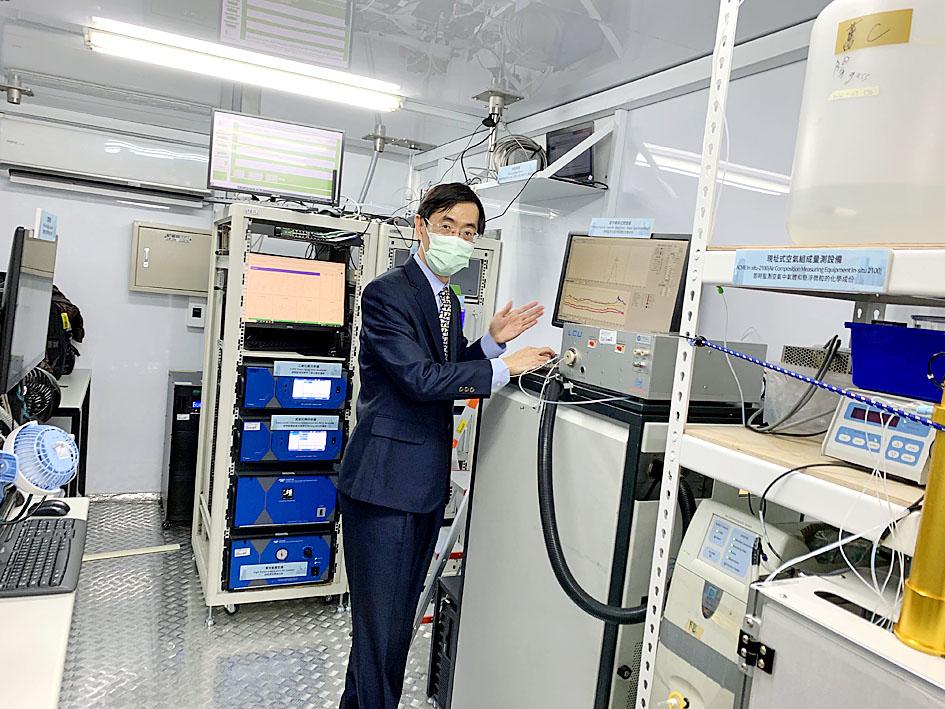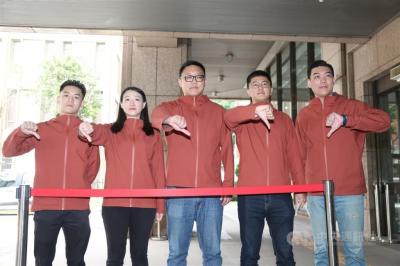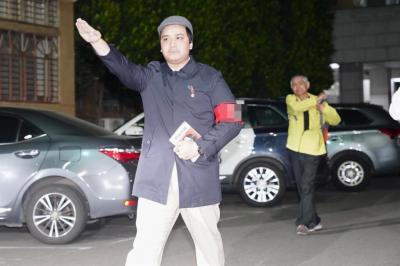An air quality monitoring station has been set up in Taichung to determine the composition of air pollutants in the city, researchers said on Sunday.
The Surface Air Pollution Research Station, which was established by Academia Sinica’s Research Center for Environmental Changes and the Taichung City Environmental Protection Bureau at a cost of NT$100 million (US$3.62 million), would collect and analyze air samples over the next four years, said Charles Chou (周崇光), CEO of the center’s Air Quality Research Center.
In a project led by Academia Sinica researchers, the station would take precise measurements of more than 100 types of fine particulates smaller than 2.5 micrometers (PM2.5) and ozone precursors, which would help the city devise policies to combat sources of air pollution, he said.

Photo: Tsai Shu-yuan, Taipei Times
Average concentrations of PM2.5 in the city have decreased annually over the past several years, but people have grown more aware of the dangers of air pollution, the effects of which are more obvious during the fall and winter months, he said, adding that air pollution still affects visibility in central and southern Taiwan during the winter.
“The complex physical and chemical properties of air pollution mean it is necessary to perform precise analysis on samples to come up with effective policies to combat it,” he said.
Taichung’s geographical location, which faces winds from the land and sea, the urban heat island effect, and valley and monsoon winds, adds to the complexity of understanding air pollution in the city, he said.
The station, which is the first of its kind in Taiwan, was set up on the roof of Taichung’s Second Municipal Government Building.
The project would involve research into the physical and chemical processes of air pollution in central Taiwan, including sources of emission, and how pollutants are transmitted and transformed, center director Chen Yue-gau (陳于高) said.
Researchers would use satellite and surface telemetry technology, optical radars, Internet of Things devices and artificial intelligence, he said.
The team would also use flue samples to analyze the composition of volatile organic compounds, he said.
The annual average concentration of PM2.5 in Taichung dropped to 15.4 micrograms per cubic meter in 2020, which is near the national standard of 15 micrograms per cubic meter, Taichung Environmental Protection Bureau Director Chen Hung-yi (陳宏益) said.
“However, the closer we get to that standard, the more difficult it becomes to further lower the PM2.5 level. Last year the level even rose in some parts of the country,” he said.
Ozone pollution is also a growing problem for several counties and municipalities nationwide, he said.

Taiwan is stepping up plans to create self-sufficient supply chains for combat drones and increase foreign orders from the US to counter China’s numerical superiority, a defense official said on Saturday. Commenting on condition of anonymity, the official said the nation’s armed forces are in agreement with US Admiral Samuel Paparo’s assessment that Taiwan’s military must be prepared to turn the nation’s waters into a “hellscape” for the Chinese People’s Liberation Army (PLA). Paparo, the commander of the US Indo-Pacific Command, reiterated the concept during a Congressional hearing in Washington on Wednesday. He first coined the term in a security conference last

Prosecutors today declined to say who was questioned regarding alleged forgery on petitions to recall Democratic Progressive Party (DPP) legislators, after Chinese-language media earlier reported that members of the Chinese Nationalist Party (KMT) Youth League were brought in for questioning. The Ministry of Justice Investigation Bureau confirmed that two people had been questioned, but did not disclose any further information about the ongoing investigation. KMT Youth League members Lee Hsiao-liang (李孝亮) and Liu Szu-yin (劉思吟) — who are leading the effort to recall DPP caucus chief executive Rosalia Wu (吳思瑤) and Legislator Wu Pei-yi (吳沛憶) — both posted on Facebook saying: “I

The Ministry of Economic Affairs has fined Taobao NT$1.2 million (US$36,912) for advertisements that exceed its approved business scope, requiring the Chinese e-commerce platform to make corrections in the first half of this year or its license may be revoked. Lawmakers have called for stricter enforcement of Chinese e-commerce platforms and measures to prevent China from laundering its goods through Taiwan in response to US President Donald Trump’s heavy tariffs on China. The Legislative Yuan’s Finance Committee met today to discuss policies to prevent China from dumping goods in Taiwan, inviting government agencies to report. Democratic Progressive Party Legislator Kuo Kuo-wen (郭國文) said

Sung Chien-liang (宋建樑), who led efforts to recall Democratic Progressive Party (DPP) Legislator Lee Kun-cheng (李坤城), was released on bail of NT$80,000 today amid outcry over his decision to wear a Nazi armband to questioning the night before. Sung arrived at the New Taipei District Prosecutors’ Office for questioning in a recall petition forgery case last night wearing a red armband bearing a swastika, carrying a copy of Adolf Hitler’s Mein Kampf and giving a Nazi salute. Sung left the building at 1:15am without the armband and covering the book with his coat. Lee said today that this is a serious